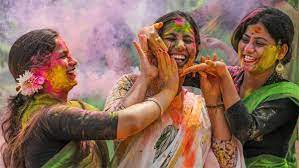Holi is considered as one of the most revered and celebrated festivals of India and it is celebrated in almost every part of the country. It is also sometimes called as the “festival of love” as on this day people get to unite together forgetting all resentments and all types of bad feeling towards each other. The great Indian festival lasts for a day and a night, which starts in the evening of Purnima or the Full Moon Day in the month of Falgun. It is celebrated with the name Holika Dahan or Choti Holi on first evening of the festival and the following day is called Holi. In different parts of the country it is known with different names.
Holi, Hindu spring festival celebrated throughout North India on the full-moon day of Phalguna (February–March). Participants throw coloured water and powders on one another, and, on this one day only, license is given for the usual rankings of caste, gender, status, and age to be reversed. In the streets the celebrations are often marked by ribald language and behaviour, but at its conclusion, when everyone bathes, dons clean white clothes, and visits friends, teachers, and relatives, the ordered patterns of society are reasserted and renewed. Holi begins on Sunday, March 28, 2021
The vibrancy of colors is something that brings in a lot of positivity in our lives and Holi being the festival of colours is actually a day worth rejoicing. Holi is a famous Hindu festival that is celebrated in every part of India with utmost joy and enthusiasm. The ritual starts by lighting up the bonfire one day before the day of Holi and this process symbolizes the triumph of good over the bad. On the day of Holi people play with colours with their friends and families and in evening they show love and respect to their close ones with Abeer.


Post a Comment
If you have any questions ! please let me know